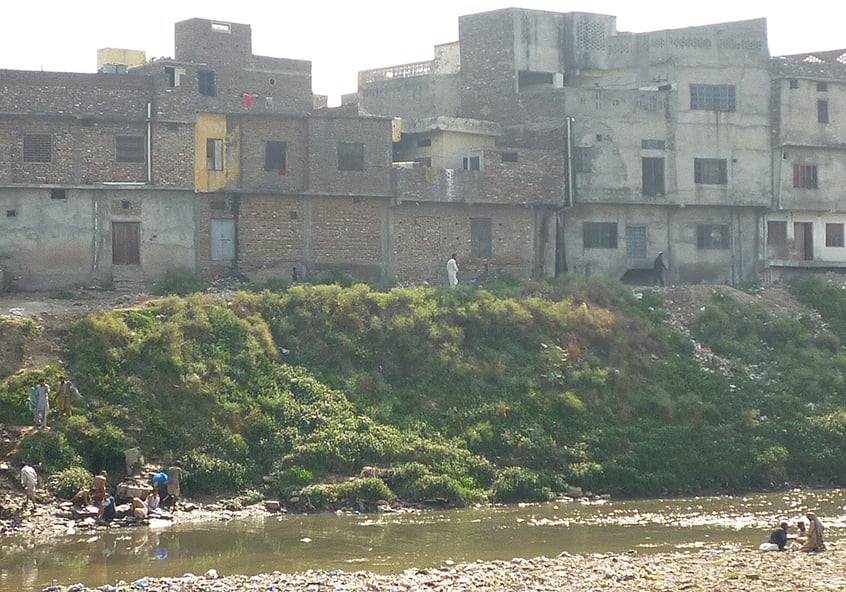Something in the water: how surveillance can help to combat disease
London School of Hygiene & Tropical Medicine https://lshtm.ac.uk/themes/custom/lshtm/images/lshtm-logo-black.png Tuesday 8 August 2023
The first time I visited an environmental surveillance (ES) site was back in 2015. It was hot, the sampled river was black and meandering between backyards of houses (see the photo above). The river had pipes where sewage was deposited, and the area was used to dispose of refuse. Further downstream women were washing clothes and kids were splashing around. But just a month before a river sample yielded poliovirus, related to cases elsewhere in the country. I was in Rawalpindi, Pakistan. At that time, and even now, ES is supplementing clinical surveillance to support polio eradication. By taking samples from many sites across the country, sometimes from contaminated rivers but also from sewage systems, epidemiologists gain information about the presence of poliovirus in communities. If poliovirus is found, epidemiologists respond with extra vaccination activities, aiming to extinguish the virus.
In recent Correspondence in Nature Medicine scientists and stakeholders define a research agenda for ES applied to multiple pathogens. There has been a huge expansion of ES in recent years and improvement in technologies available to examine wastewater for pathogens. However, application of these novel surveillance approaches has been limited in low resource settings. Our research agenda aims to clarify the diseases to prioritise, describe what ES should look like, and how this and clinical data should be used by public health officials to improve public health.
The diseases to prioritise are those for which there is a significant health burden or need to eradicate, sufficient evidence that the pathogen or genetic material can be reliably detected in wastewater, and for which there is a clear opportunity (eg. an available vaccine) to reduce disease burden. For some pathogens there are known challenges with clinical data because of the high proportion of infections that are hidden (poliovirus) or limitations in clinical diagnostics of labs (Salmonella typhi), meaning that ES can add a lot to knowledge of the distribution of pathogens. For others, eg. cholera and measles, research is needed to understand the utility of ES as a reliable early warning for epidemics. Research is also needed to improve the utility of testing for SARS-CoV-2 in wastewater; the effect of multiple factors (rainfall, contamination, variant effects) on these values is not well characterised, especially in low-resource settings, meaning that this surveillance data is under-utilised.
Critical to leveraging the applied research is the clarification of surveillance goals for these pathogens. A challenge for stakeholders is how to balance a surveillance system designed to detect importation of poliovirus while also giving sufficient early warning of an increase in SARS-CoV-2 in vulnerable communities. Does one size fit all, or does the aspiration of a multi-pathogen surveillance system need to be explicit about prioritisation needs? This, and many other questions remain relatively unanswered. As a researcher actively involved in this area, it makes for interesting and exciting research activities ahead.
In 2022 I was awarded a Bill and Melinda Gates Foundation grant that aims to tackle some of these research questions. In this award my team are working closely with the National Institute for Communicable Diseases (South Africa) and the Christian Medical College (Vellore, India), who have expanded their ongoing ES to include multiple pathogens. Central to the award is to ensure in-country researchers have the skills and tools to carry out analysis themselves. Using statistical analysis and mathematical modelling, we aim to develop tools to support decisions in surveillance set-up and in the analysis of data generated through environmental and clinical surveillance. I’m optimistic that this work, and many other active projects in this area will improve how environmental and clinical data are used to understand extent of pathogen distribution, and provide stakeholders with the information and tools that improve public health.
LSHTM's short courses provide opportunities to study specialised topics across a broad range of public and global health fields. From AMR to vaccines, travel medicine to clinical trials, and modelling to malaria, refresh your skills and join one of our short courses today.